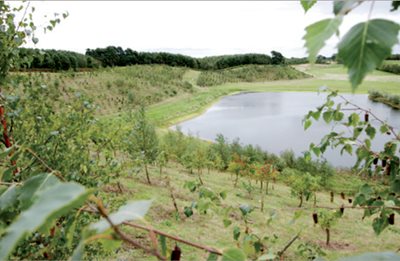Aggregates
Aggregates are the major component of concrete by volume and are inherently a low carbon product. Most are naturally occurring materials requiring little processing and are usually locally sourced, with the associated benefit of reducing carbon associated with transportation.
The standard for aggregates in concrete (BS EN 12620) provides a wide selection of potential local aggregates available for use. Specifying a precise aggregate can be more carbon intensive and less economic, so it is recommended that designers contact the local concrete supplier to find out about the local aggregate to the area.
The UK leads Europe in recycling rates for hard demolition waste, and sources of secondary aggregates are utilised by the industry. Primary aggregates are needed and as a resource are abundant. Their extraction is tightly regulated, and sites of mineral extraction are restored, often to an enhanced state, delivering significant biodiversity benefits.
Coarse aggregates
Coarse aggregates are particles greater than 4.75mm, but generally range between 9.5mm to 37.5mm in diameter. They can either be from Primary, Secondary or Recycled sources. Primary, or 'virgin', aggregates are either Land- or Marine-Won. Gravel is a coarse marine-won aggregate; land-won coarse aggregates include gravel and crushed rock. Gravels constitute the majority of coarse aggregate used in concrete with crushed rock making up most of the remainder.
Secondary aggregates are materials which are the by-products of extractive operations and are derived from a very wide range of materials.
Recycled concrete is a viable source of aggregate and has been satisfactorily used in granular subbases, soil-cement, and in new concrete. Recycled aggregates are classified in one of two ways, as:
- Recycled Aggregate (RA), or as
- Recycled Concrete Aggregate (RCA).
Fine aggregates
Fine aggregate are basically sands won from the land or the marine environment. Fine aggregates generally consist of natural sand or crushed rock fines, with most particles passing through a 9.5mm sieve. As with coarse aggregates these can be from Primary, Secondary or Recycled sources.
Lightweight aggregates
Lightweight aggregates are manufactured from natural materials or from the manufacture or processing of industrial by-products. The required properties of the lightweight concrete will have a bearing on the best type of lightweight aggregate to use.
Enhancing biodiversity and quarrying

Over 700 sites of special scientific interest are current and former mineral extraction sites. The significant contribution to UK biodiversity from the minerals sector is being increasingly recognised.
The aggregates sector is a key part of a partnership programme Nature after Minerals (NAM). NAM has stated that the restoration of sites of mineral extraction represents the largest expansion of habit in the UK. The industry’s investment in restoration is uniquely placed to enable the UK to achieve biodiversity targets that will directly safeguard the future of 960 priority species. Case studies, advice and further information can be found at www.afterminerals.com